What Type of Pan is Best for Frying?
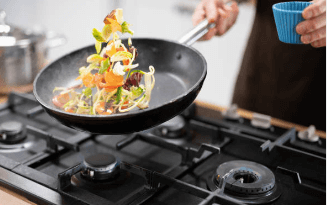
Many home stay moms who love to make delicious food for their family just like you. Frying is one of the common processes to add different dishes at the table. You may be wondering what type of pan is best for frying.
There are many types of pans that can be used for frying. The best type of pan to use for frying depends on the food being fried and the desired outcome. For example, if you are frying chicken, you may want a pan that is non-stick so that the chicken does not stick to the pan and can be easily turned.
If you are frying fish, you may want a pan that has a bit of texture so that the fish skin can get crispy.
What type of pan is best for frying?
When it comes to frying, there are a few different factors to consider when choosing the right type of pan. The most important factor is the material the pan is made from.
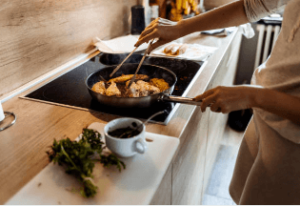 For example, aluminum pans are popular because they conduct heat well and are inexpensive. However, aluminum can also react with certain foods, so if you’re planning on cooking something acidic (like tomatoes), it’s best to avoid using an aluminum pan.
For example, aluminum pans are popular because they conduct heat well and are inexpensive. However, aluminum can also react with certain foods, so if you’re planning on cooking something acidic (like tomatoes), it’s best to avoid using an aluminum pan.
Another option is stainless steel, which doesn’t react with food and is easy to clean. However, stainless steel doesn’t conduct heat as evenly as aluminum, so it’s not the best choice for delicate tasks like flipping pancakes or eggs.
If you’re looking for a middle ground between these two materials, try using a non-stick pan. Non-stick surfaces make flipping and removing food much easier, and they’re usually made from materials that conduct heat well. No matter what type of pan you choose, be sure to season it before use.
This will help create a non-stick surface and prevent food from sticking to the bottom of the pan.
Best Type of Frying Pan for Health
When it comes to cooking, there are many different methods and techniques that can be used. One of the most popular methods is frying, as it allows for food to be cooked quickly and easily. However, when it comes to frying, not all pans are created equal. In fact, some pans can be better for your health than others. So, if you’re looking for the best type of frying pan for health, here’s what you need to know.
One of the best types of frying pans for health is a ceramic pan. Ceramic pans are non-stick and don’t require the use of any harmful chemicals or oils in order to cook with them. This means that they’re a much healthier option than other types of frying pans on the market. Additionally, ceramic pans are also very easy to clean, which further adds to their appeal.
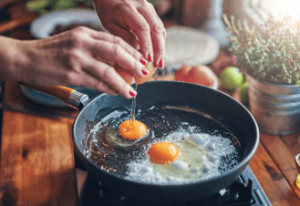
If you’re looking for a more affordable option, then consider an aluminum pan. Aluminum pans are also non-stick and don’t require the use of any harmful chemicals or oils in order to cook with them. However, they’re not quite as durable as ceramic pans and may not last as long. Nevertheless, they’re still a great option if you’re looking for a cheaper way to fry your food without compromising on quality or safety.
Finally, if you want the absolute best option when it comes to healthfulness and safety, then consider investing in a stainless steel pan. Stainless steel is incredibly durable and doesn’t require the use of any harmful chemicals or oils in order to cook with it. Additionally, it’s very easy to clean and will last you for many years to come. If you can afford it, stainless steel is definitely the way to go!
Best Frying Pan Material
When it comes to finding the best frying pan, material is everything. The type of material you choose will determine how well your food cooks, how easy the pan is to clean, and how long it will last. With so many options on the market, it can be tough to know which material is right for you.
Here’s a breakdown of the most popular materials used in frying pans, so you can make an informed decision when shopping for your next pan.
Stainless steel: Stainless steel is one of the most popular materials used in frying pans. It’s durable, conducts heat evenly, and is easy to clean. One downside of stainless steel is that it can cause sticking if not properly seasoned or oiled.
Cast iron: Cast iron pans are a classic choice for fryers. They’re incredibly durable and retain heat well, making them ideal for cooking at high temperatures.
Cast iron pans need to be seasoned before use (which means coating them in oil and baking them) to prevent sticking and rusting. Once they’re properly seasoned, they’re practically non-stick.
Copper:
Despite their high cost, copper frying pans have excellent heat conductivity. Because of this, you have more control over how quickly they warm up and cool down.
Carbon steel: Carbon steel frying pans are similar to cast iron pans in terms of durability and heat retention. They also need to be seasoned before use, but don’t require as much upkeep as cast iron pans do—you only need to season them every few months or so instead of before each use. Carbon steel pans also have a shorter heating time than cast iron pans do.
Non-stick: Non-stick frying pans are coated with a material (usually Teflon) that prevents food from sticking to the surface of the pan while cooking.
Non-stick surfaces make cleanup a breeze and are great for delicate foods that might stick or tear easily on other types of surfaces (like fish or eggs).
Types of Frying Pans (What type of pan is best for frying)
When it comes to frying pans, there are a few different types that you can choose from. Each type of frying pan has its own unique benefits that can make your cooking experience better. Here is a look at the different types of frying pans so that you can choose the best one for your needs:
Stainless Steel Frying Pan
If you’re in the market for a new frying pan, stainless steel is a great option. Stainless steel frying pans are durable, easy to clean, and have excellent heat conductivity. When shopping for a stainless steel frying pan, it’s important to choose one that has a thick base, as this will help to prevent warping and ensure even cooking.
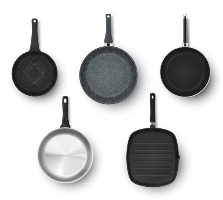
Additionally, make sure to look for a pan with riveted handles – this will add extra stability and durability. Finally, consider the size of the pan – you’ll want one that’s big enough to comfortably cook for your family or guests, but not so large that it’s cumbersome to use.
With these factors in mind, you’re sure to find the perfect stainless steel frying pan for your needs!
Cast Iron Frying Pan:
Since cast iron frying pans are virtually indestructible, many families pass them down through the centuries. That increases the appeal of their normally inexpensive price. Additionally, with proper maintenance, cast iron can acquire a patina that releases food nearly as effectively as nonstick. However, because the pans are hefty, heating them up takes time because they take a while to reach the proper temperature. But once they do, they continue to generate heat.
The versatility of cast-iron cookware is demonstrated by our tests on both coated and uncoated versions. To test how well a cast-iron skillet performs for home cooks, we sear steaks, roast scallops, and bake cornbread. The top pans pass each of these evaluations. We also evaluate how simple it is to clean them.
Copper Frying Pan:
Although copper frying pans are pricey, they have excellent heat conductivity. This means that they heat up fast and cool off quickly, providing you with greater flexibility when preparing a dish that requires close monitoring, such as caramel sauce.
If you’re baking a dessert like a tarte Tatin, you can use a copper pan, but keep in mind that copper can’t withstand the high heat of stainless steel or cast iron pans, therefore most manufacturers discourage using heats above 450 °F.
Carbon Steel Frying Pan
Carbon steel frying pans are a great option for those who want the benefits of both a cast iron and stainless steel pan. They are perfect for browning and searing food, as well as holding heat better than other materials. Carbon steel is also more affordable than other options, making it a great choice for budget-minded cooks.
When caring for your carbon steel frying pan, be sure to season it regularly to prevent rust and sticking. With proper care, your carbon steel fryer will last you many years!
Ceramic Frying Pan
If you enjoy cooking at home, then you know that having the right cookware is important. A good frying pan can make all the difference when it comes to making a delicious meal. And if you’re looking for a high-quality option, then a ceramic frying pan may be the way to go.
Ceramic pans are made from a type of clay that is fired at high temperatures. This gives them a non-stick surface that is both durable and easy to clean. Plus, they conduct heat evenly, which means your food will cook evenly as well.
One thing to keep in mind with ceramic pans is that they require a little bit of extra care. For example, you’ll need to use wooden or silicone utensils so you don’t scratch the surface. And while they are dishwasher safe, it’s best to hand wash them to extend their lifespan.
With proper care, a ceramic frying pan can last for years and provide you with countless meals. So if you’re in the market for new cookware, consider giving one of these pans a try – you might just be surprised by how much you like it!
 Non-stick Frying Pans:
Non-stick Frying Pans:
These dishes transfer readily from the frying pan to the plate when using nonstick skillets. Non-stick pans eliminate the problem of food sticking and need little oil for cooking. Additionally, they are lightweight, inexpensive, and simple to clean. But a cast-iron or stainless steel frying pan’s tremendous heat is too much for them to handle. Additionally, they don’t survive as long as copper, stainless steel, or cast-iron frying pans.
Made in Frying Pan:
Do you think that all frying pans are created equal? Well, think again! The folks at Made in cookware have created a line of American-made frying pans that are the real deal.
These handcrafted beauties are made from heavy gauge carbon steel and they come in three sizes: 8 inches, 10 inches, and 12 inches. The natural nonstick coating is safe to use and it’s also PFOA and PTFE free. Plus, the ergonomic handle ensures comfort while cooking.
So go ahead and make the switch to Made in cookware today!
Best Pan for Deep Frying
If you’re looking for the best pan for deep frying, you’ve come to the right place. In this post, we’ll take a look at what makes a good deep frying pan and some of the best options on the market. Deep frying is a popular cooking method that involves submerging food in hot oil.
This cooking method can be used to cook up a variety of foods, from chicken and fish to french fries and onion rings. When it comes to choosing a pan for deep frying, there are a few things you’ll want to keep in mind.
First, you’ll want to choose a pan that is large enough to accommodate the amount of food you plan on cooking.
Second, you’ll want to choose a pan that has high sides so that the oil doesn’t splatter when you’re cooking.
And lastly, you’ll want to choose a pan that is made from heat-resistant material so that it can withstand the high temperatures involved in deep frying.
Some of the best materials for deep fry pans include cast iron, stainless steel, or enameled steel.
These materials are durable and will hold up well under high heat. When it comes to size, most home cooks will want to choose a 12-inch or 14-inch fry pan. And as far as price goes, you can find quality deep fry pans for anywhere from $20-$100+.
So those are some things to keep in mind when shopping for the best deep fry pan. Now let’s take a look at some specific product recommendations.
What is the Best Material for a Frying Pan?
If you’re looking for the best material for a frying pan, there are a few things to consider. First, think about what you’ll be using the pan for most often. If you’ll be cooking mostly delicate foods like fish or eggs, then you’ll want a material that won’t stick and is easy to clean. Stainless steel or ceramic coated aluminum are good choices in this case.
If you’ll be cooking more hearty fare like steak or chicken, then you can go with a heavier-duty option like cast iron or carbon steel. These materials will hold up better to high heat and heavy use. No matter what material you choose, make sure it has a good non-stick coating. This will help prevent sticking and make cleanup a breeze.
Also look for pans with an ergonomic handle that’s comfortable to grip and won’t get too hot when cooking on the stovetop.
Frequently Asked Questions:
- What Type of Pan Should Be Used for Pan Frying?
There are many different types of pans that can be used for pan frying, but the most important factor to consider is the material. Non-stick surfaces are ideal for pan frying because they prevent sticking and make flipping and removing food much easier. However, it is important to use a lower heat when cooking with non-stick surfaces to avoid damaging the coating.
Stainless steel and cast iron pans are also good options for pan frying, but require more oil to prevent sticking. Whichever type of pan you choose, be sure to preheat it before adding any oil or food.
- What is the Healthiest Frying Pan to Use?
When it comes to finding the healthiest frying pan to use, there are a few things to keep in mind. The first is the material the pan is made of. If you can, choose a pan that is made of stainless steel, ceramic or cast iron.
These materials are less likely to leach chemicals into your food. Another thing to consider is the size of the pan. A smaller pan will require less oil to cook with, and therefore will be healthier for you.
Finally, make sure that the pan has a non-stick coating. This will help to prevent sticking and burning, which can release harmful chemicals into your food.
- Can Nonstick Pans Be Used for Frying?
Sure! Nonstick pans are great for frying because they have a smooth surface that prevents sticking and makes flipping and removing food easy. They also tend to be lightweight, so they’re easy to maneuver.
Plus, many nonstick pans have a coating that is specially designed to withstand high heat, making them ideal for cooking at high temperatures.
Conclusion
In general, a pan with shallow sides is the best type of pan for frying. This allows the oil to heat up quickly and evenly, so that your food can cook evenly as well. I think you got a clear answer for your question about what type of pan is best for frying from above details.
Learn more about How to trick an induction cooker?

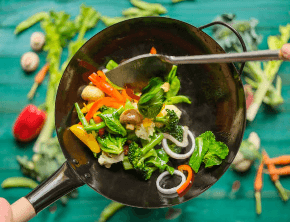
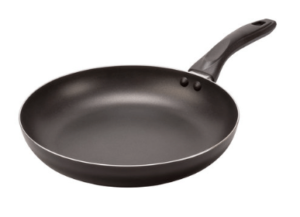 Non-stick Frying Pans:
Non-stick Frying Pans:

Comments(0)